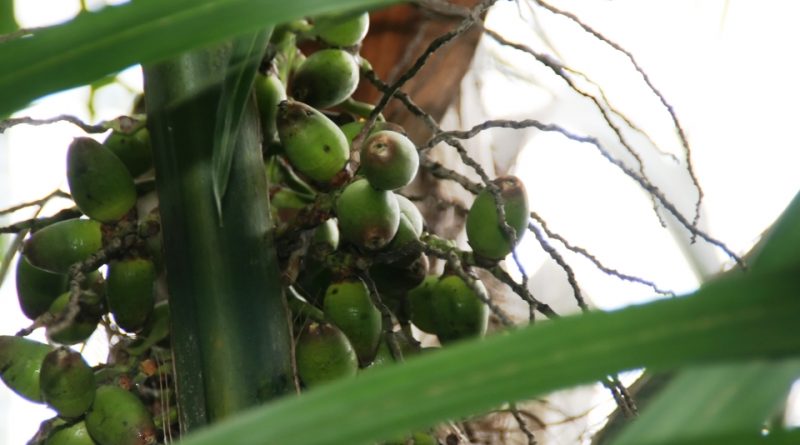Syagrus stenopetala
Syagrus stenopetala
The cococito (Syagrus stenopetala Burret, 1932) is an arboreal species belonging to the Arecaceae family.
Systematic –
From a systematic point of view it belongs to:
Eukaryota domain,
Kingdom Plantae,
Division Magnoliophyta,
Class Liliopsida,
Subclass Arecidae,
Order Arecales,
Arecaceae family,
Subfamily Arecoideae,
Cocoseae Tribe,
Subtribe Attaleinae,
Genus Syagrus,
Species S. stenopetala.
Etymology –
The term Syagrus is not known, however the most accredited hypothesis is that it derives from the name “syagrus” given by Pliny the Elder (23/24 AD – 79) to a variety of date palm.
The specific epithet stenopetala comes from the Greek terms “στενός” (stenós), i.e. narrow and “πέταλον” (pétalon), i.e. petal, in reference to its morphology.
Geographic Distribution and Habitat –
Syagrus stenopetala is a plant native to the northern coastal area of Venezuela.
Its habitat is that of semi-deciduous forests on rocky or sandy soils, between 100 and 700 m above sea level.
Description –
Syagrus stenopetala is a palm, generally tufted, with trunks of 10-15 m and 10-18 cm in diameter.
It is a monoecious palm, rarely solitary, with erect or curved light gray stems which tend to darken in the older part and on which the annular traces of fallen leaves are visible.
The leaves are located on a short petiole; they are pinnate, slightly arched, up to about 2.5 m long, with 90-110 pairs of linear leaflets with asymmetrical sharp apex, rather rigid, irregularly arranged in groups of 2-4 along the rachis and inserted at different angles, but mainly upwards, 50-70 cm long in the central part and 2.3-2.5 cm wide, of an intense green color above, slightly lighter below. The leaf base, 1-1.6 m long, open on the side opposite the petiole, has fibrous margins.
The inflorescences form between the leaves; they are up to over 1 m long, cream coloured, initially enclosed in a woody spathe about 1 m long, with first order ramifications and unisexual flowers arranged in triads (one female flower between two males), except in the terminal part of the rachilles where only solitary or paired male flowers are present.
The fruits are ellipsoid in shape, 3-4.5 cm in length and 2-2.5 cm in diameter, yellow-orange in color with the apex covered by a brown tomentum.
Inside they contain a single ellipsoid seed 2.5-3.5 cm long and 1.5-2 cm in diameter.
Cultivation –
Syagrus stenopetala is a rarely cultivated palm but with potential for cultivation as an ornamental species in gardens in tropical areas due to its thin stems and elegant foliage.
Cultivation can take place both in tropical and subtropical climate regions where as adults it can resist exceptional temperature values around 0 °C, with possible damage to the foliage.
To grow it needs full sun or partial shade and adapts to different types of soil, as long as it is draining, from sandy to clayey, from slightly acidic to alkaline, it can overcome short dry periods, but it is preferable to water it regularly in climates with long summers hot and dry.
This palm reproduces by seed, previously kept in water for 3 days, in draining soil kept moist at a temperature of 26-28 °C, with germination times of 10-18 weeks.
Customs and Traditions –
Syagrus stenopetala is a plant native to the northern coastal area of Venezuela where it is known by some local names, including: cococito, corozo, cocuyito, palmita, yaraco.
This palm was considered for a certain period to be synonymous with Syagrus orinocensis; however, it was subsequently separated and considered a distinct species due to its bushy habit, the different places and environments of origin and other details regarding flowers and fruits.
The fruits are edible, but with fibrous pulp, and used to feed domestic animals.
The drums are used in indigenous homes.
Preparation Method –
Syagrus stenopetala is a palm used only locally for food purposes even if its fruits, although edible, are somewhat fibrous.
Other parts of the plant are used as roofing or building materials in indigenous villages.
Guido Bissanti
Sources
– Acta Plantarum – Flora of the Italian Regions.
– Wikipedia, the free encyclopedia.
– GBIF, the Global Biodiversity Information Facility.
– Useful Tropical Plants Database.
– Conti F., Abbate G., Alessandrini A., Blasi C. (ed.), 2005. An annotated checklist of the Italian vascular flora, Palombi Editore.
– Pignatti S., 1982. Flora d’Italia, Edagricole, Bologna.
– Treben M., 2000. Health from the Lord’s Pharmacy, Advice and experiences with medicinal herbs, Ennsthaler Editore.
Photo source:
– https://upload.wikimedia.org/wikipedia/commons/0/01/Syagrus_stenopetala_3zz.jpg
– https://www.rarepalmseeds.com/syagrus-stenopetala
Attention: Pharmaceutical applications and food uses are indicated for informational purposes only, they do not represent in any way a medical prescription; we therefore decline any responsibility for their use for healing, aesthetic or food purposes.


